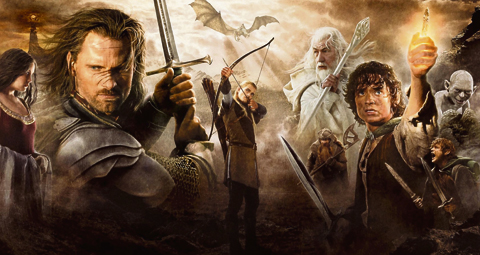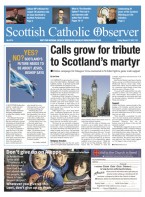March 10 | ![]() 0 COMMENTS
0 COMMENTS ![]() print
print

Seeking God in the Lord of the Rings
NIALL GOOCH argues that JRR Tolkien’s epic series of novels has inspired a generation of young Catholics
When I worked for a pro-life charity, students sometimes used to ask me how best they could serve the pro-life cause. I offered different answers to this question at different times, but the one I gave most often was that they should become a novelist, a playwright, or a writer for TV and film—some kind of storyteller, at any rate. Stories matter very deeply and fundamentally, particularly perhaps in the early part of our lives when we are striving to make sense of the world and our place within it.
The author Philip Pullman (no friend of the Catholic Church) once said: “‘Thou Shalt Not’ might reach the head, but it takes ‘Once upon a time’ to reach the heart.” What he means is that for most people, the kind of stories that surround us shape the way in which we see the world more effectively and permanently than if we simply hear dry lists of rules or moral imperatives.
The films we watch and the books we read contribute to what you might call our moral imagination—that is to say they create in us a semi-conscious web of expectations about how we and those around us will and should behave and interact. It should not be surprising then that young Catholics should often find great solace and attraction in stories that help them see the world through Catholic eyes, and to develop a Catholic imagination.
A book that fulfils this role for many has been JRR Tolkien’s Lord Of The Rings. This is not an obvious example of a book set in a Catholic world, perhaps surprisingly when you consider that Mr Tolkien was a daily Mass Catholic with strong traditionalist sympathies.
No formal religion of any kind is to be found in Middle Earth. The city of Minas Tirith has no soaring Gothic cathedral to go with the rest of its high medieval architecture.
The reader will look in vain for Our Lady of Hobbiton nestling quietly amid the fields and woods of The Shire. The Riders of Rohan do not dismount to hear Mass before going into battle.
Middle Earth is barely even pagan. Systematic religious belief simply doesn’t feature, and the most widespread spiritual impulse is a strong but vague reverence for ancestors.
“I go to my fathers,” whispers King Theoden as he lies dying on the field of battle, but it’s not clear that even this reflects a real belief in an actual afterlife. The Elves are a strange case; they are apparently immortal, though they can be killed in battle and most eventually choose to sail across the sea to the Undying Lands, which is not dissimilar to the Christian vision of Heaven. But they don’t follow a religion in any meaningful sense.
There are frequent signs that the author was immersed in a Christian understanding of human existence and the moral life.
Mr Tolkien has a subtler touch in this respect than his friend and contemporary CS Lewis, whose Narnia books, though well-written and imaginative, can seem didactic and heavy-handed in their use of Christian allegory.
Mr Tolkien’s Christian themes, by contrast, feel unforced, emerging organically from the world that he so painstakingly imagined—note, for instance, the analogy between lembas bread and the Eucharist (which entirely passed me by on my first reading!) and the Christian overtones of Gandalf’s death and rebirth.
Or indeed the rather Catholic flavour to the idyllic existence of the hobbits, with its emphasis on feasting and the good life and its strong adherence to the rhythms of the year.
There is an understated but heartbreaking moment in The Two Towers when a mistrustful Sam interrupts a moment of genuine moral clarity and even repentance for Gollum, thus losing an opportunity for redemption forever.
A mysterious but ultimately trustworthy providence seems to work throughout the book, not only sometimes making wrong deeds work for good but also drawing great good out of small acts of virtue. The clearest example of this is that the ultimate destruction of the Ring is enabled and ensured by Bilbo’s act of mercy in not killing Gollum many years before.
There are obvious resonances here with Romans 8v28: “God works with those who love him, those who have been called in accordance with his purpose, and turns everything to their good.”
It is also arguable, of course, that Bilbo’s forbearance unknowingly allows a great deal of evil and misery, because it is only through Gollum that the War of the Ring begins. Mr Tolkien refuses neat answers about the workings of providence—quite rightly, because on this side of Heaven there will always be difficult and disturbing questions about the interplay between human free will and evil and God’s action in the world.
He also neatly uses the Ring to explore other tensions and ambiguities around good and evil and human nature. It’s never made entirely clear how exactly the Ring exerts its malevolent power. Does it have an evil nature all of its own which works to corrupt individuals, or does the promise of power simply draw out the possibilities for evil which exist in all of us? Or both?
Quite rightly, Mr Tolkien never gives a definitive answer, not least I suspect because he didn’t think there was one, just as in Christian faith we have to live with tensions about the source and nature of our own and others’ wrongdoing. The Ring is one of the devices that Mr Tolkien uses to draw out with considerable force and clarity one of his key themes: the dangers of power, and of the desire for power.
Gandalf begs Frodo not to give him the Ring because he fears that he could not resist the associated temptations.
Boromir loses his life and endangers the whole mission of the Fellowship trying to seize the Ring from Frodo. Saruman falls entirely into evil because of his desire for order and control.
He is not the first in Mr Tolkien’s world to have done so—do not do evil that good may come is a firm teaching of St Paul and a constant drumbeat in Lord Of The Rings.
The depth and texture of Mr Tolkien’s world invites Catholic comparisons. He describes a very old world, full of ruins, legends, half-remembered lore and haunted landscapes. It does not take a great leap of imagination to see parallels with the Church, with its long and complex history encompassing the rise and fall of great men, proud civilisations and seemingly invincible ideologies.
In the Church, as in Middle Earth, there are kings and poets and wise men and fools and hermits and great numbers of ordinary people muddling along.
Everywhere we find little pockets of eccentricity and oddity among the normal and the everyday, which brings to mind many of the saints of the Church.
Fundamentally, it is an enchanted world, with many layers of meaning which are not reducible to mere words, and I suspect this makes it attractive to Catholics. We follow a religion of sacraments and mysteries, a Faith rich in poetry and art which views the created world as good and important.
Another Christian theme that runs throughout the books is the love of home and hearth, which reflects the desire for a final, perfect rest.
Most of the central characters have powerful yearnings to restore what has been lost, to put an end to exile and enable themselves to be fully at home in the world again. This is true of Aragorn, seeking to restore the kingdom lost by his forefathers; it is true of the dwarves, who seek to restore the greatness of their lost cities; it is true of the Elves, who see decay and loss all around them.
It is also true of the ostensibly undramatic hobbits, when they arrive home at the end of all their exploring to find that The Shire has been taken over and badly marred.
In all these feelings is the reflection and echo of a greater and deeper need that humans in the real world have, for final reconciliation and entry into a heavenly home.
Mr Tolkien teases out this theme in the experience of Frodo, who comes home to the Shire and aids in its rebuilding, but constantly feels the pull of another, truer home—the Undying Lands.
In a world which ignores or scorns the Catholic Church, it is deeply refreshing to come across a work which joyfully, skilfully and beautifully illustrates the timeless truths of the Faith.
As Aragorn says: “Good and ill have not changed since yesteryear… It is a man’s part to discern them.”
Lord Of The Rings will be read and welcomed for as long as young Catholics seek such discernment.











